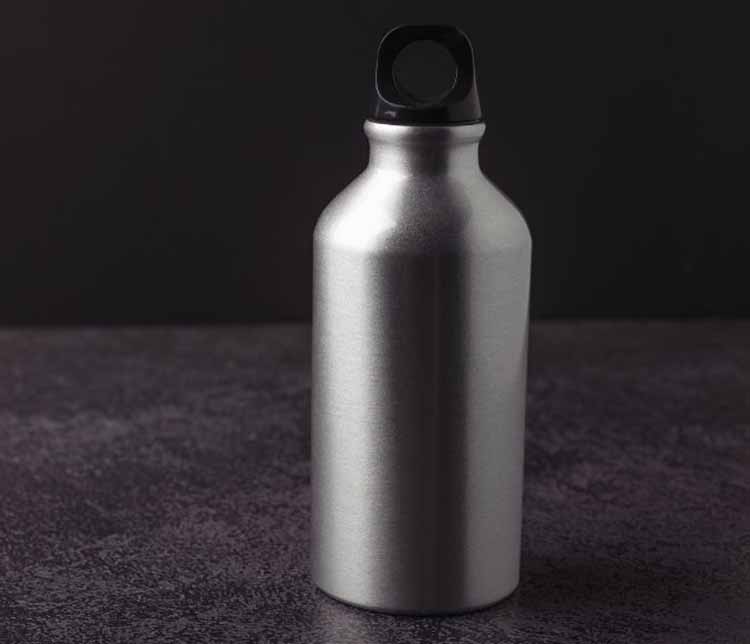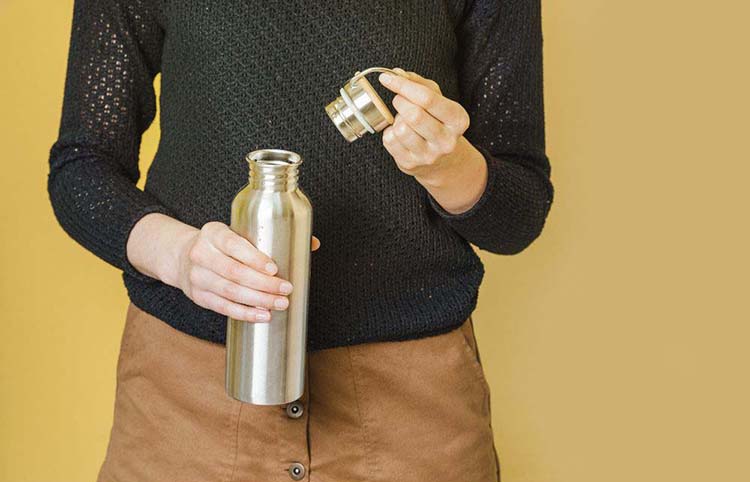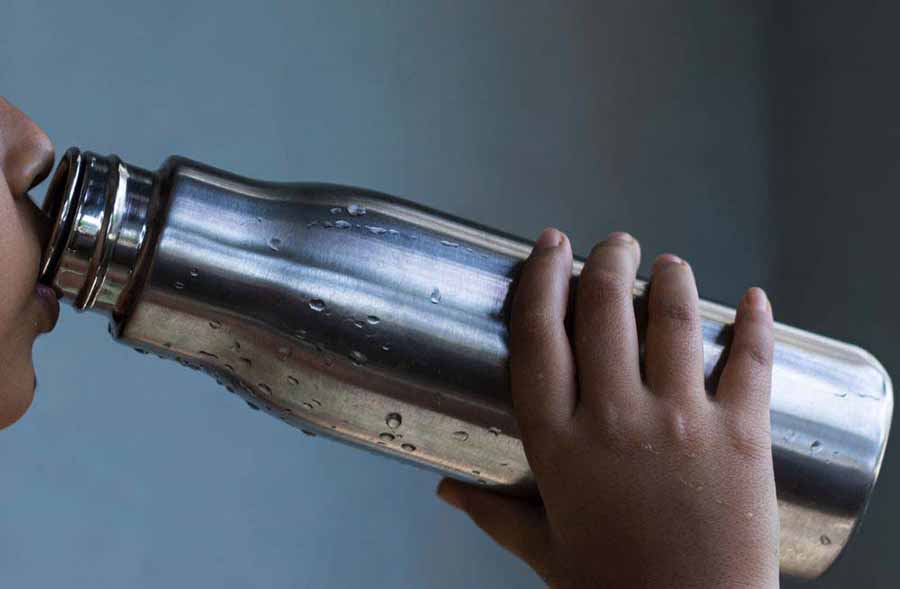If you’re curious about finding the safest water bottle material out there, you’ve come to the right place. Although stainless steel water bottles are heavier and costlier than other materials such as plastic and aluminum, why are they the most popular?
Are stainless steel water bottles safe to drink from? Is this the key reason for their popularity?
Yes, stainless steel water bottles are safe to drink from. They are made from food-grade stainless steel, which does not allow chemicals to leach into your water. This material is also resistant to rust and corrosion so it doesn’t degrade over time when properly maintained.
Scroll down to learn about the stainless steel water bottle regulations, the pros and cons of stainless steel bottles, and the best cleaning processes to keep the bottles safe.
What Are Stainless Steel Water Bottles?
Stainless steel is an alloy which means that it’s a mix of metals such as iron, nickel, and chromium. The chromium is what makes it ‘stainless’. It creates a protective layer that prevents rust and corrosion.
The most common type of stainless steel used in the bottles is food-grade 18-8 stainless steel, also known as 304 stainless steel. This steel includes 18% chromium & 8% nickel. This composition makes the bottles safe and free from harmful chemicals like BPA, lead, or toxins.
Most stainless steel water bottles are made with a single layer of metal. However, some are double-walled and vacuum-sealed. This creates a gap between the inner and outer walls, which acts like insulation.
Regardless of the type of stainless steel used in your water bottle, the part that touches your drink is usually food-grade stainless steel. So no harmful materials are leaching into your water.
Recommended: The Best Green Water Bottles
Are Stainless Steel Water Bottles Safe to Drink From?
Yes, stainless steel water bottles are safe to drink from, thanks to their high-quality construction and inert materials. Inert materials do not react with the drinks or leach chemicals into the water.
Unlike some plastic water bottles, these are free of BPA and other potentially harmful compounds. Since stainless steel is naturally resistant to rust and corrosion, it doesn’t leave a metallic taste in the drink.
Even if the bottle is dented or scratched, food-grade stainless steel doesn’t release any harmful substances.
However, there’s a catch. Some low-quality stainless steel bottles may contain trace amounts of lead, particularly in seals. So, you must look for reputable brands using certified food-grade stainless steel to ensure complete safety.

Stainless Steel Water Bottle Regulations in The USA
Below are the stainless regulations related to stainless steel water bottles. Knowing the points will help you understand how the bottles pass different levels to ensure safety.
Food and Drug Administration (FDA) Regulations
The US Food and Drug Administration (FDA) regulates stainless steel water bottles under the Code of Federal Regulations Title 21 (21 CFR). This regulation targets the materials of the bottle and their manufacturing processes.
It ensures that there are acceptable levels of certain substances such as heavy metals and chemicals like bisphenol A (BPA) do not exceed safe levels. Manufacturers must ensure their products comply with these standards to be legally sold in the U.S.
California Proposition 65
California’s Proposition 65 gives warnings on products containing harmful chemicals, carcinogens, or chemicals that are related to birth defects. Products sold in California must comply with this regulation by proving through lab testing that harmful substances do not exceed certain levels.
Lab Testing and Compliance
Manufacturers undergo third-party lab testing to verify compliance with both 21 CFR and California Proposition 65. This testing confirms that the bottles do not contain harmful or restricted substances above set thresholds. Testing costs typically range from $200 to $300 per product.
Country of Origin and Packaging Regulations
In the U.S., stainless steel bottles must display a Country of Origin label. Packaging materials must also meet specific safety standards to prevent contamination from substances like heavy metals, which are regulated in certain states.
Manufacturers and importers follow these regulations to ensure that their stainless steel water bottles are safe to drink from and legally marketable.
Recommended: Lightweight Aluminum Water Bottle

Are Stainless Steel Water Bottles Safer Than Plastic and Aluminum?
Yes, stainless steel water bottles are safer than plastic and aluminum bottles. Stainless steel is a non-reactive material. It means the bottle does not leach chemicals into the water, even when exposed to heat or sunlight.
In contrast, some plastics can release chemicals such as BPA, which is linked to health risks.
Aluminum bottles are safer than plastic water bottles. They do not leach metal into the water. But they need to be lined with a plastic material to prevent metal leaching or a metallic taste in the drinks.
However, it’s also not a problem until the plastic gets damaged and leaches harmful substances. If the liner is compromised, it can potentially leach chemicals.
Stainless steel’s durability, chemical stability, and typically toxin-free composition make it a safer choice for reusable water bottles.
Pros and Cons of Stainless Steel Water Bottles
Stainless steel water bottles are not only safe but also they offer some compelling benefits. And, just like everything else, they have some drawbacks too. Here are the pros and cons of stainless steel water bottles.
Pros
- Durability: Highly resistant to dents and damage, making them long-lasting.
- Safety: Free from chemicals like BPA, lead, and phthalates.
- Temperature Retention: Good at maintaining the temperature of liquids, both hot and cold.
- Non-reactive: Does not leach chemicals or alter the taste of the contents.
- Eco-Friendly: Reusable and recyclable, reducing plastic waste.
- Easy to Clean: Stainless steel is generally dishwasher safe or you can easily clean it with warm soapy water.
Cons
- Weight: Stainless steel bottles are heavier than plastic bottles, especially larger ones.
- Cost: Generally more expensive than disposable plastic bottles, though cost-effective in the long run.
- Dents: While durable, stainless steel can dent if you drop the bottle hard.
- Condensation: Double-walled bottles can cause condensation on the outside which makes them slippery.
Do Stainless Steel Water Bottles Get Moldy?
Stainless steel water bottles are highly resistant to mold growth compared to plastic bottles.
It’s because stainless steel bottles have a non-porous surface, which means they do not harbor bacteria and fungi as easily as other materials might.
However, mold can still form in any type of water bottle if you don’t clean and dry the bottle regularly. The areas like the cap or the bottle’s seal are more prone to get moldy as these places contain moisture.
To prevent mold, it’s important to clean your stainless steel water bottle regularly with hot, soapy water and let it dry fully open. For a deeper clean, using a mixture of vinegar and water can help remove any stubborn mold or odors.
How to Clean Stainless Steel Water Bottles to Keep It Safe?
The safety of your stainless steel water bottle also depends on how often and how well you clean and dry the bottle. Here we will discuss how you can keep the safest by proper cleaning methods.
Regular Cleaning Process
- Daily Rinse: Rinse your stainless steel water bottle with warm water after each use. If you have stored anything other than water, move on to the next step.
- Soap Wash: Use mild dish soap and warm water to clean the inside of your bottle. A bottle brush can be helpful to scrub the interior surface of the bottle more effectively.
- Rinse Thoroughly: Rinse out all soap residues to avoid altered tests.
- Dry: Don’t overlook the importance of drying the bottle completely. The retained moisture inside the bottle can trigger bacteria growth.
Deep Cleaning Process
- Vinegar Soak: Fill the bottle with a mixture of white vinegar and water (a 1:1 ratio) and let it sit overnight. Vinegar is effective at killing bacteria and neutralizing odors.
- Baking Soda Scrub: After the vinegar soak, if there’s still residue or odor, use a baking soda paste (3 parts baking soda to 1 part water) to scrub inside the bottle.
- Rinse and Dry: Rinse the bottle thoroughly after deep cleaning and let it dry completely.
FAQs
How Long Is Water Good in A Stainless Steel Bottle?
Water in a stainless steel bottle can stay fresh for a few days if the bottle is clean and tightly sealed. The longevity depends on the purity of your water as well. The water’s taste and freshness last longer if you keep the bottle out of direct sunlight and heat.
Are Stainless Steel Flasks Safe for Alcohol?
Yes, stainless steel flasks are safe for storing alcohol. These bottles are durable and do not react with alcoholic beverages. Stainless steel does not leach chemicals into alcohol, unlike some plastics or metals.
Do stainless steel bottles rust?
Stainless steel bottles do not rust easily because they are made from a corrosion-resistant alloy. They are made of 18/8 or 304 stainless steel, which contains chromium and nickel. These materials form a passive layer of chromium oxide that prevents rust and maintains the integrity of the steel for a long time.
Conclusion
And, we’re at the end of the discussion regarding ‘are stainless steel water bottles safe to drink from?’
Stainless steel water bottles are the safest material among other options. If you want an alternative option that’s safe like stainless steel, you can go for glass water bottles. Although glass can easily break or shatter, they’re also at the top when it comes to safety.
Drink water, stay hydrated!

